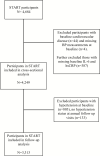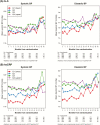Role of Inflammatory Biomarkers in the Prevalence and Incidence of Hypertension Among HIV-Positive Participants in the START Trial
- PMID: 31800000
- PMCID: PMC6931895
- DOI: 10.1093/ajh/hpz132
Role of Inflammatory Biomarkers in the Prevalence and Incidence of Hypertension Among HIV-Positive Participants in the START Trial
Abstract
Background: The association between hypertension (HTN) and inflammatory biomarkers (interleukin-6 [IL-6] and high-sensitivity C-reactive protein [hsCRP]) in HIV-positive persons with CD4+ count >500 cells/mm3 is unknown.
Methods: We studied HTN in participants of the Strategic Timing of AntiRetroviral Treatment (START) trial of immediate vs. deferred antiretroviral therapy (ART) in HIV-positive, ART naive adults with CD4+ count > 500 cells/mm3. HTN was defined as having a systolic blood pressure (BP) ≥140 mmHg, a diastolic BP ≥90 mmHg, or using BP-lowering therapy. Logistic and discrete Cox regression models were used to study the association between baseline biomarker levels with prevalent and incident HTN.
Results: Among 4,249 participants with no history of cardiovascular disease, the median age was 36 years, 55% were nonwhite, and the prevalence of HTN at baseline was 18.9%. After adjustment for race, age, gender, body mass index (BMI), diabetes, smoking, HIV RNA and CD4+ levels, associations of IL-6 and hsCRP with HTN prevalence were not significant (OR per twofold higher:1.10, 95% confidence interval [CI]: 0.99, 1.20 for IL-6 and 1.05, 95% CI: 0.99, 1.10 for hsCRP). Overall incidence of HTN was 6.8 cases/100 person years. In similarly adjusted models, neither IL-6 (Hazard ratios [HR] per twofold higher IL-6 levels: 0.97, 95% CI: 0.88, 1.08) nor hsCRP (HR per twofold higher hsCRP levels: 0.97, 95% CI: 0.92, 1.02) were associated with risk of incident HTN. Associations did not differ by treatment group. Age, race, gender, and BMI were significantly associated with both the prevalence and incidence of HTN.
Conclusions: Traditional risk factors and not baseline levels of IL-6 or hsCRP were associated with the prevalence and incidence of HTN in START.
Trial registration: ClinicalTrials.gov NCT00867048.
Keywords: HIV; blood pressure; hypertension; inflammation; traditional risk factors.
© American Journal of Hypertension, Ltd 2019. All rights reserved. For Permissions, please email: journals.permissions@oup.com.
Figures


References
-
- Armah KA, Chang CC, Baker JV, Ramachandran VS, Budoff MJ, Crane HM, Gibert CL, Goetz MB, Leaf DA, McGinnis KA, Oursler KK, Rimland D, Rodriguez-Barradas MC, Sico JJ, Warner AL, Hsue PY, Kuller LH, Justice AC, Freiberg MS; Veterans Aging Cohort Study (VACS) Project Team . Prehypertension, hypertension, and the risk of acute myocardial infarction in HIV-infected and -uninfected veterans. Clin Infect Dis 2014; 58:121–129. - PMC - PubMed
-
- Hemkens LG, Bucher HC. HIV infection and cardiovascular disease. Eur Heart J 2014; 35:1373–1381. - PubMed
-
- Freiberg MS, Chang CC, Kuller LH, Skanderson M, Lowy E, Kraemer KL, Butt AA, Bidwell Goetz M, Leaf D, Oursler KA, Rimland D, Rodriguez Barradas M, Brown S, Gibert C, McGinnis K, Crothers K, Sico J, Crane H, Warner A, Gottlieb S, Gottdiener J, Tracy RP, Budoff M, Watson C, Armah KA, Doebler D, Bryant K, Justice AC. HIV infection and the risk of acute myocardial infarction. JAMA Intern Med 2013; 173:614–622. - PMC - PubMed
-
- Friis-Møller N, Reiss P, Sabin CA, Weber R, Monforte A, El-Sadr W, Thiébaut R, De Wit S, Kirk O, Fontas E, Law MG, Phillips A, Lundgren JD, Group DS. Class of antiretroviral drugs and the risk of myocardial infarction. N Engl J Med. 2007;356:1723–35. - PubMed
Publication types
MeSH terms
Substances
Associated data
Grants and funding
LinkOut - more resources
Full Text Sources
Medical
Research Materials

